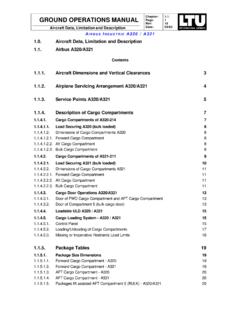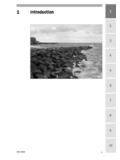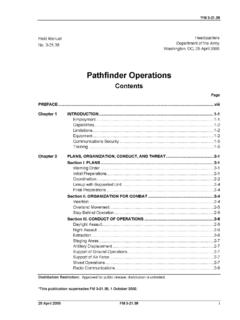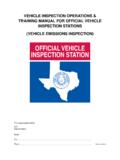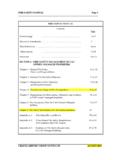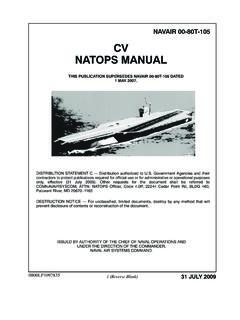Transcription of Helicopter Operations Short FAA Chapter 10 - mmfireems.com
1 Federal Aviation Administration Aeronautical Information manual Official Guide to: Basic Flight Information and ATC Procedures FAA Chapter 10. Helicopter Operations Section 1. Helicopter IFR Operations 10-1-1. Helicopter Flight Control Systems 10-1-2. Helicopter Instrument Approaches 10-1-3. Helicopter Approach Procedures to VFR Heliports 10-1-4. The Gulf of Mexico Grid System Section 2. Special Operations 10-2-1. Offshore Helicopter Operations 10-2-2. Helicopter Night VFR Operations 10-2-3. Landing Zone Safety 10-2-4. Emergency Medical Service (EMS) Multiple Helicopter Operations Section 2. Special Operations 10-2-2. Helicopter Night VFR Operations a. Effect of Lighting on Seeing Conditions in Night VFR Helicopter Operations NOTE- This guidance was developed to support safe night VFR Helicopter emergency medical services (HEMS) Operations . The principles of lighting and seeing conditions are useful in any night VFR operation. While ceiling and visibility significantly affect safety in night VFR Operations , lighting conditions also have a profound effect on safety.
2 Even in conditions in which visibility and ceiling are determined to be visual meteorological conditions, the ability to discern unlighted or low contrast objects and terrain at night may be compromised. The ability to discern these objects and terrain is the seeing condition, and is related to the amount of natural and man made lighting available, and the contrast, reflectivity, and texture of surface terrain and obstruction features. In order to conduct Operations safely, seeing conditions must be accounted for in the planning and execution of night VFR Operations . Night VFR seeing conditions can be described by identifying high lighting conditions and low lighting conditions. 1. High lighting conditions exist when one of two sets of conditions are present: (a) The sky cover is less than broken (less than 5/8 cloud cover), the time is between the local Moon rise and Moon set, and the lunar disk is at least 50% illuminated; or (b) The aircraft is operated over surface lighting which, at least, provides for the lighting of prominent obstacles, the identification of terrain features (shorelines, valleys, hills, mountains, slopes) and a horizontal reference by which the pilot may control the Helicopter .
3 For example, this surface lighting may be the result of: (1) Extensive cultural lighting (man-made, such as a built-up area of a city), (2) Significant reflected cultural lighting (such as the illumination caused by the reflection of a major metropolitan area's lighting reflecting off a cloud ceiling), or (3) Limited cultural lighting combined with a high level of natural reflectivity of celestial illumination, such as that provided by a surface covered by snow or a desert surface. 2. Low lighting conditions are those that do not meet the high lighting conditions requirements. 3. Some areas may be considered a high lighting environment only in specific circumstances. For example, some surfaces, such as a forest with limited cultural lighting, normally have little reflectivity, requiring dependence on significant moonlight to achieve a high lighting condition. However, when that same forest is covered with snow, its reflectivity may support a high lighting condition based only on starlight.
4 Similarly, a desolate area, with little cultural lighting, such as a desert, may have such inherent natural reflectivity that it may be considered a high lighting conditions area regardless of season, provided the cloud cover does not prevent starlight from being reflected from the surface. Other surfaces, such as areas of open water, may never have enough reflectivity or cultural lighting to ever be characterized as a high lighting area. 4. Through the accumulation of night flying experience in a particular area, the operator will develop the ability to determine, prior to departure, which areas can be considered supporting high or low lighting conditions. Without that operational experience, low lighting considerations should be applied by operators for both pre-flight planning and Operations until high lighting conditions are observed or determined to be regularly available. b. Astronomical Definitions and Background Information for Night Operations 1. Definitions (a) Horizon.
5 Wherever one is located on or near the Earth's surface, the Earth is perceived as essentially flat and, therefore, as a plane. If there are no visual obstructions, the apparent intersection of the sky with the Earth's (plane) surface is the horizon, which appears as a circle centered at the observer. For rise/set computations, the observer's eye is considered to be on the surface of the Earth, so that the horizon is geometrically exactly 90 degrees from the local vertical direction. (b) Rise, Set. During the course of a day the Earth rotates once on its axis causing the phenomena of rising and setting. All celestial bodies, the Sun, Moon, stars and planets, seem to appear in the sky at the horizon to the East of any particular place, then to cross the sky and again disappear at the horizon to the West. Because the Sun and Moon appear as circular disks and not as points of light, a definition of rise or set must be very specific, because not all of either body is seen to rise or set at once.
6 (c) Sunrise and sunset refer to the times when the upper edge of the disk of the Sun is on the horizon, considered unobstructed relative to the location of interest. Atmospheric conditions are assumed to be average, and the location is in a level region on the Earth's surface. (d) Moonrise and moonset times are computed for exactly the same circumstances as for sunrise and sunset. However, moonrise and moonset may occur at any time during a 24 hour period and, consequently, it is often possible for the Moon to be seen during daylight, and to have moonless nights. It is also possible that a moonrise or moonset does not occur relative to a specific place on a given date. (e) Transit. The transit time of a celestial body refers to the instant that its center crosses an imaginary line in the sky - the observer's meridian - running from north to south. (f) Twilight. Before sunrise and again after sunset there are intervals of time, known as twilight, during which there is natural light provided by the upper atmosphere, which does receive direct sunlight and reflects part of it toward the Earth's surface.
7 (g) Civil twilight is defined to begin in the morning, and to end in the evening when the center of the Sun is geometrically 6 degrees below the horizon. This is the limit at which twilight illumination is sufficient, under good weather conditions, for terrestrial objects to be clearly distinguished. 2. Title 14 of the Code of Federal Regulations applies these concepts and definitions in addressing the definition of night (Section ), the requirement for aircraft lighting (Section ) and pilot recency of night experience (Section ). c. Information on Moon Phases and Changes in the Percentage of the Moon Illuminated From any location on the Earth, the Moon appears to be a circular disk which, at any specific time, is illuminated to some degree by direct sunlight. During each lunar orbit (a lunar month), we see the Moon's appearance change from not visibly illuminated through partially illuminated to fully illuminated, then back through partially illuminated to not illuminated again.
8 There are eight distinct, traditionally recognized stages, called phases. The phases designate both the degree to which the Moon is illuminated and the geometric appearance of the illuminated part. 10-2-3. Landing Zone Safety a. This information is provided for use by Helicopter emergency medical services (HEMS) pilots, program managers, medical personnel, law enforcement, fire, and rescue personnel to further their understanding of the safety issues concerning Landing Zones (LZs). It is recommended that HEMS operators establish working relationships with the ground responder organizations they may come in contact with in their flight Operations and share this information in order to establish a common frame of reference for LZ selection, Operations , and safety. b. The information provided is largely based on the booklet, LZ - Preparing the Landing Zone, issued by National Emergency Medical Services Pilots Association (NEMSPA), and the guidance developed by the University of Tennessee Medical Center's LIFESTAR program, and is used with their permission.
9 C. Information concerning the estimation of wind velocity is based on the Beaufort Scale. d. Selecting a Scene LZ 1. If the situation requires the use of a Helicopter , first check to see if there is an area large enough to land a Helicopter safely. FIG 10-2-4 Recommended Minimum Landing Zone Dimensions 2. For the purposes of FIG 10-2-4 the following are provided as examples of relative Helicopter size: (a) Small Helicopter : Bell 206/407, Eurocopter AS-350/355, BO-105, BK-117. (b) Medium Helicopter : Bell UH-1 (Huey) and derivatives (Bell 212/412), Bell 222/230/430 Sikorsky S-76, Eurocopter SA-365. (c) Large Helicopter : Boeing Chinook, Eurocopter Puma, Sikorsky H-60 series (Blackhawk), SK-92. 3. The LZ should be level, firm and free of loose debris that could possibly blow up into the rotor system. 4. The LZ should be clear of people, vehicles and obstructions such as trees, poles and wires. Remember that wires are difficult to see from the air. The LZ must also be free of stumps, brush, post and large rocks.
10 See FIG 10-2-5. FIG 10-2-5 Landing Zone Hazards 5. Keep spectators back at least 200 feet. Keep emergency vehicles 100 feet away and have fire equipment standing by. Ground personnel should wear eye protection, if available, during landing and takeoff Operations . To avoid loose objects being blown around in the LZ, hats should be removed; if helmets are worn, chin straps must be securely fastened. 6. Fire fighters should wet down the LZ if it is extremely dusty. e. Helping the Flight crew Locate the Scene 1. If the LZ coordinator has access to a GPS unit, the exact latitude and longitude of the LZ should be relayed to the HEMS pilot. If unable to contact the pilot directly, relay the information to the HEMS ground communications specialist for relaying to the pilot, so that they may locate your scene more efficiently. Recognize that the aircraft may approach from a direction different than the direct path from the takeoff point to the scene, as the pilot may have to detour around terrain, obstructions or weather in route.
